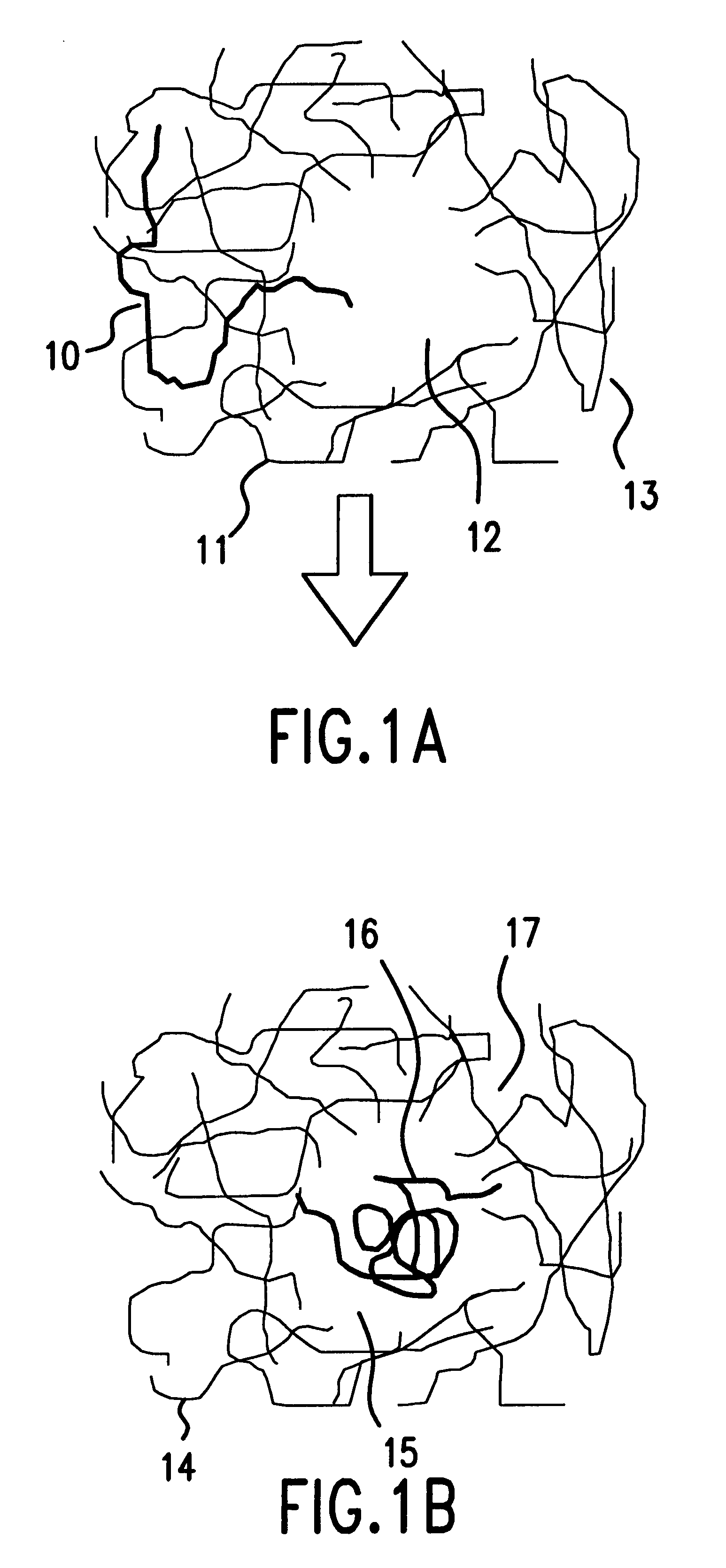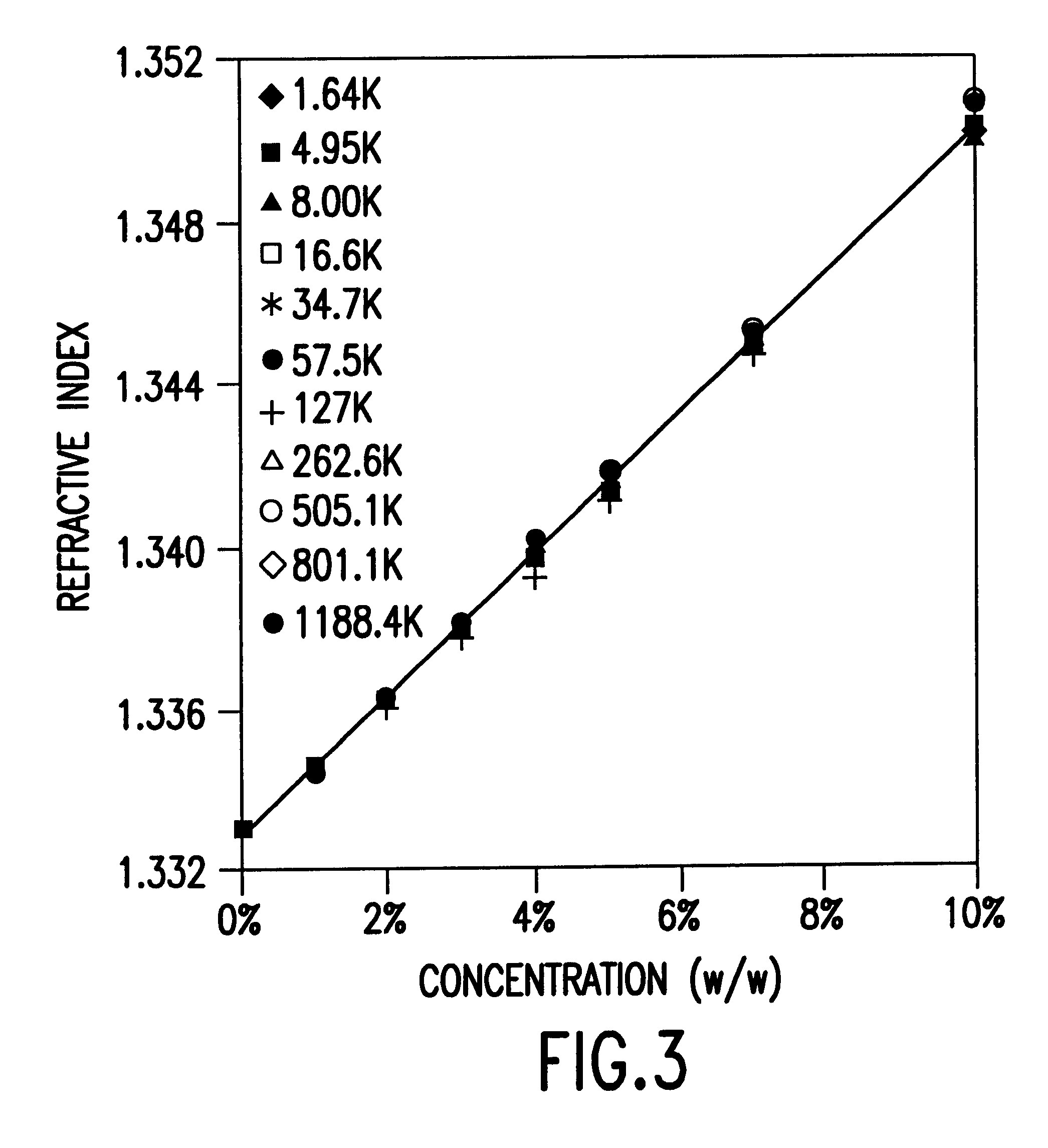Hydrogel materials with crystalline colloidal array of watervoids for detection and macromolecule separations
a technology of colloidal array and watervoids, which is applied in the field of hydrogel materials with colloidal array of watervoids for detection and macromolecule separation, can solve the problems of unclear relevance of any of these approaches to polymer diffusion in a swollen polymeric gel matrix, and the difficulty of quantitative comparison of theoretical and experimental results
- Summary
- Abstract
- Description
- Claims
- Application Information
AI Technical Summary
Problems solved by technology
Method used
Image
Examples
example 2
The intensity and wavelength of light that is Bragg diffracted by the array of water voids in the HPCCA, as prepared according to Example 1, depend upon the refractive indices of the scattering entities 29 (n.sub.Void), the interstitial gel medium 28 pores (n.sub.Medium), and the overall crystal (n.sub.Crystal). These refractive indices in turn depend upon their corresponding chemical compositions. Therefore, by analyzing the diffraction profile changes, one can sensitively probe these refractive index changes. This approach, was used to monitor the NAPSS polymer concentrations in the HPCCA medium (pores) and voids.
The following expressions relate the refractive indices of these regions to the local NaPSS solution concentrations:
n.sub.void =n.sub.Water (1-C.sub.H)+n.sub.PSS C.sub.H (1)
n.sub.Medium =n.sub.AMD.phi..sub..alpha. +(1-.phi..sub..alpha.).left brkt-bot.n.sub.Water (1-C.sub.G)+n.sub.PSS C.sub.G.right brkt-bot. (2)
n.sub.Crystal =n.sub.Medium (1-.phi..sub.Void)+n.sub.Void.phi....
example 3
Assuming that the partitioning of the NAPSS polymer chains from the reservoir solution into the porous hydrogel medium is identical in the presence or absence of the CCA, one can independently determine C.sub.G by an absorption spectroscopy. Blank hydrogel films, 200 pm thick, were made with the same composition as that of the PCCA but without the silica CCA. The absorption spectra of the blank hydrogel film in water and in NaPSS solutions of different concentrations and molecular weights were then measured. Difference absorption spectra were used to minimize the total background contributions from the scattering and absorption of the hydrogel network.
FIG. 5 shows the concentration dependence of the NaPSS absorption and a typical calibration curve at 265 nm. The calibration curves are linear over the entire concentration range studied. By comparing the NAPSS absorption in the gel media and in the reservoir solution, Cg, values for each particular molecular weight and reservoir conce...
example 4
Although the hydrogel films used were highly crosslinked and rigid, they still slightly changed volume for different NaPSS concentrations. This gel volume change is an important issue since it alters the HPCCA lattice parameters and the size of the voids. Consequently, the overall change in the diffraction profiles will contain the contributions not only from refractive index changes but also from gel volume changes.
One may parameterize Equations (1)-(11) with the gel swelling ratio (r), defined as the ratio of the gel volume soaked in a particular NAPSS solution over that in pure water. Assuming a homogeneous change throughout the hydrogel, the parameters D.sub.o, d.sub.110, t.sub.o, and .phi..sub.a used in Equations (1)-(11) will change to r.sup.1 / 3 D.sub.o, r.sup.1 / 3d.sub.110, r.sup.1 / 3 t.sub.o, and r.sup.-1.phi..sub.a, respectively. Since C.sub.G is determined from the absorption measurements, there are two observables, the extinction E and the diffracted wavelength .lambda., wh...
PUM
| Property | Measurement | Unit |
|---|---|---|
| diameter | aaaaa | aaaaa |
| thick | aaaaa | aaaaa |
| volume fraction | aaaaa | aaaaa |
Abstract
Description
Claims
Application Information
 Login to View More
Login to View More - R&D
- Intellectual Property
- Life Sciences
- Materials
- Tech Scout
- Unparalleled Data Quality
- Higher Quality Content
- 60% Fewer Hallucinations
Browse by: Latest US Patents, China's latest patents, Technical Efficacy Thesaurus, Application Domain, Technology Topic, Popular Technical Reports.
© 2025 PatSnap. All rights reserved.Legal|Privacy policy|Modern Slavery Act Transparency Statement|Sitemap|About US| Contact US: help@patsnap.com



